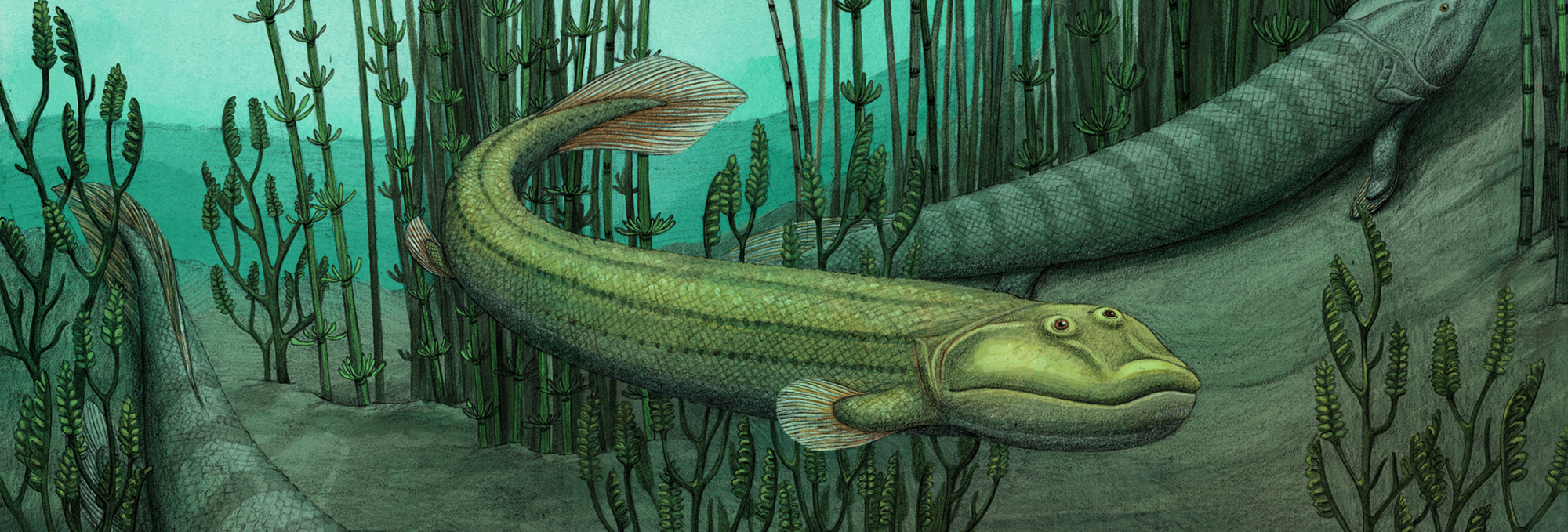
Qikiqtania wakei had four legs, like its larger cousin Tiktaalik, but was more suited for swimming than walking on land. (Illustration by Alex Boersma)
Meet Neil Shubin’s newest fossil: a fishapod that returned to water while its cousins took to land.
A meme has been circulating online featuring Tiktaalik roseae, the iconic four-legged “fishapod” that first began the transition from water to land 375 million years ago. Most variations show Tiktaalik starting to crawl ashore while a human hand threatens it with a stick. The joke is that those of us exhausted by the modern world wish we could go back in time, shoo the creature back into the water, and stop evolution in its tracks—sparing ourselves the present day of war, pestilence, and internet memes. As it turns out, one of Tiktaalik’s close relatives did just that, opting to return to life in open water after its ancestors ventured onto land.
A new study from the laboratory of Neil Shubin, who codiscovered Tiktaalik in 2004, describes Qikiqtania wakei. The fossil species closely resembles Tiktaalik but has features that made it more suited to life in the water than its adventurous cousin. The new fossil includes partial upper and lower jaws, portions of the neck, and scales. It also features a complete pectoral fin with a distinct humerus. Missing from the bone? The ridges that would indicate where muscles and joints would be on a limb geared toward walking on land. Instead, Qikiqtania’s upper arm was smooth and curved, more adapted to a life paddling underwater.
Even though Qikiqtania’s distinct pectoral fin was more suited for swimming, it wasn’t entirely fishlike. Its curved paddle shape differs from both the jointed, muscled legs of tetrapods and the fan-shaped fins of fish we see today. The uniqueness of the adaptation suggests that Qikiqtania returned to paddling the water after its ancestors developed appendages for walking.
Qikiqtania wakei was small—just 30 inches long—compared to Tiktaalik, which could grow up to nine feet. “At first we thought it could be a juvenile Tiktaalik, because it was smaller and maybe some of those processes hadn’t developed yet,” says Shubin. “But the humerus is smooth and boomerang shaped, and it doesn’t have the elements that would support it pushing up on land. It’s remarkably different and suggests something new.”
Shubin, the Robert R. Bensley Distinguished Service Professor of Organismal Biology and Anatomy, found the fossil days before Tiktaalik was discovered, at a site on southern Ellesmere Island in the territory of Nunavut in northern Arctic Canada. The name Qikiqtania (pronounced kick-kick-TAN-ee-ya) comes from the Inuktitut words Qikiqtaaluk and Qikiqtani, traditional names for the region. The species designation wakei is in memory of the late evolutionary biologist David Wake, a mentor of Shubin’s.
Shubin and his field partner, Ted Daeschler of Drexel University, collected the specimens from a quarry after spotting a few promising-looking rocks with distinctive white scales on the surface. But they sat in storage, mostly unexamined, while the team focused on preparing Tiktaalik.
Fifteen years later, in March 2020, postdoctoral researchers Justin Lemberg, AB’04, SM’18, PhD’18, and Tom Stewart, PhD’15, CT scanned one of the larger rock specimens and realized that it contained a pectoral fin. Unfortunately, it lay too deep inside the rock to get a high-resolution image, and they couldn’t do much more with it once the COVID-19 pandemic forced labs to close.
“We were trying to collect as much CT data of the material as we could before the lockdown, and the very last piece we scanned was a large, unassuming block with only a few flecks of scales visible from the surface,” says Lemberg, who is now doing cultural resource management fieldwork in Southern California. “We could hardly believe it when the first grainy images of a pectoral fin came into view.”
In the summer of 2020, when some campus facilities reopened, they contacted Mark Webster, professor of geophysical sciences, who had access to a saw that could trim pieces off the specimen so that a CT scanner could get closer and produce a better image. Stewart and Lemberg carefully marked the boundaries on the block and arranged a contactless exchange outside their lab in Culver Hall. The resulting images revealed a nearly complete pectoral fin and upper limb, including the distinctive humerus.
“That’s what blew our minds,” says Shubin. “This was by no means a fascinating block at first”—but when they studied it more closely, “look at what happened.”
Qikiqtania is slightly older than Tiktaalik; the team’s analysis places it, like Tiktaalik, adjacent to the earliest creatures known to have finger-like digits. We tend to think animals evolved in a straight line that connects their prehistoric forms to some living creature today, but Qikiqtania shows that some animals stayed on a different path that ultimately didn’t work out. Maybe that’s a lesson for those wishing Tiktaalik had stayed in the water with it.
“Tiktaalik is often treated as a transitional animal because it’s easy to see the stepwise pattern of changes from life in the water to life on land. But we know that in evolution things aren’t always so simple,” says Stewart, who joined the Penn State University faculty this summer. “We don’t often get glimpses into this part of vertebrate history. Now we’re starting to uncover that diversity and to get a sense of the ecology and unique adaptations of these animals. It’s more than simple transformation with just a limited number of species.”
